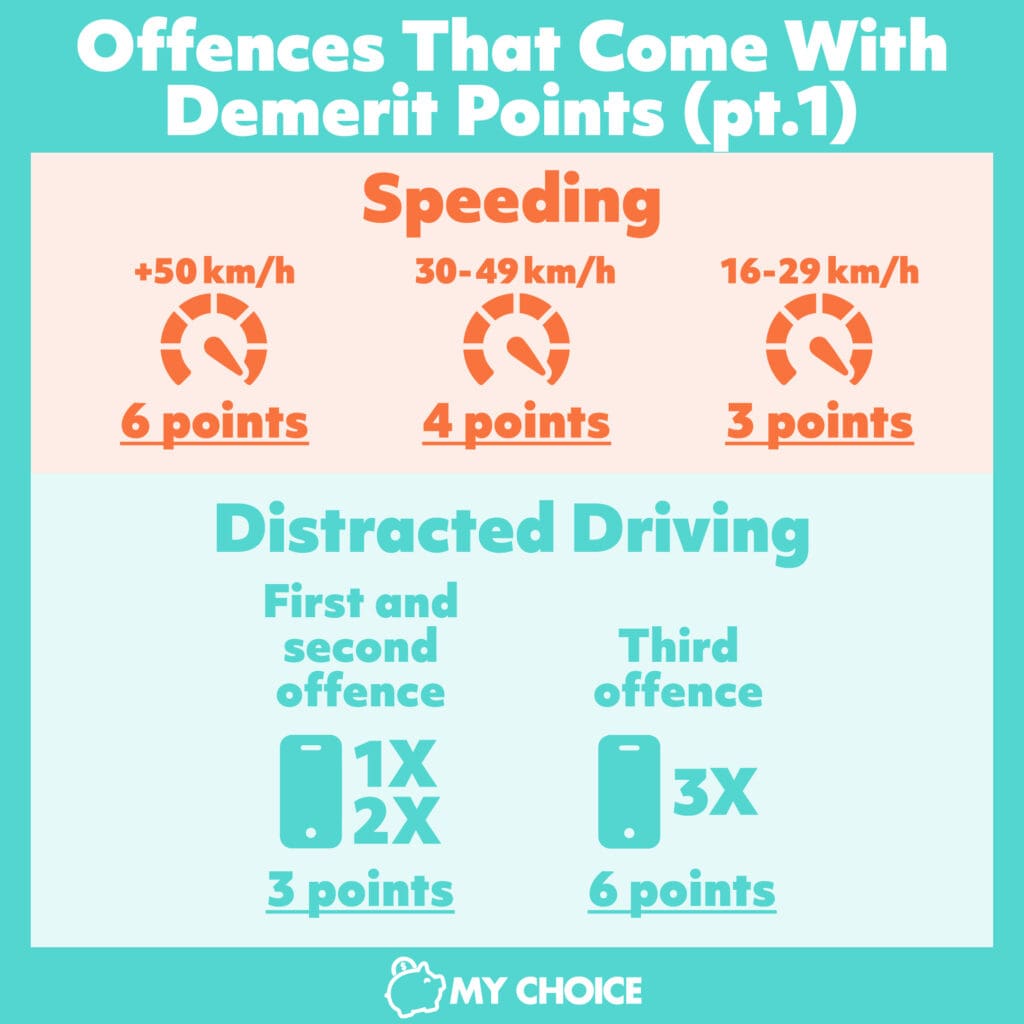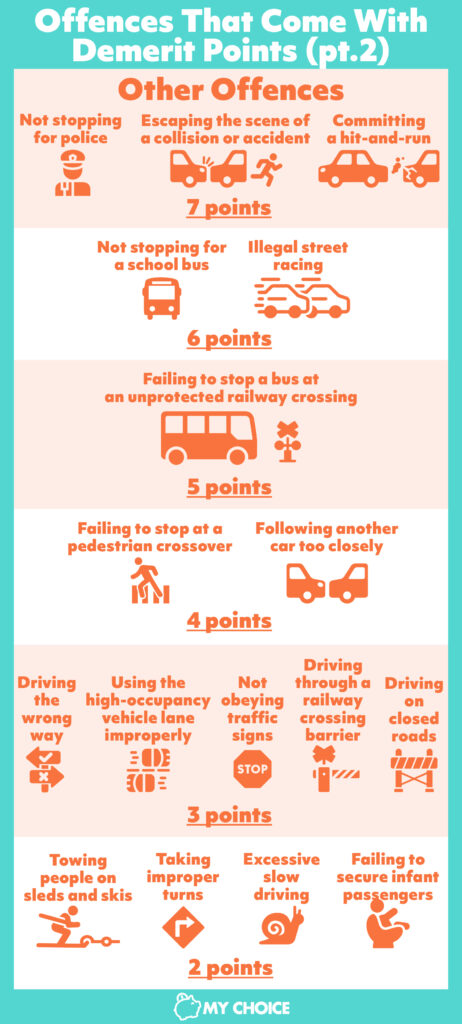
Demerit points exist to keep drivers in Ontario safe. They’re there to discourage people from driving dangerously through various penalties. People with too many driving demerit points can be sent warnings or even get their licences suspended.
But how do demerit points in Ontario work, exactly? Read on for an in-depth explanation of the demerit point system and how it affects your insurance rates.
What Is a Demerit Point?
Demerit points are “marks” added to your licence every time you commit a driving offence. You’ll be hit with heavier consequences as you gather more demerit points, up to a licence suspension.
Ontario implements the demerit system to track traffic offences. Once a driver passes a certain point threshold, they may get their licence suspended. In some cases, the driver may lose their licence entirely.
How Demerit Points Work
Every driver begins with zero demerit points. If they commit certain driving offences, they’ll accumulate points based on the severity of the offences. Naturally, some traffic violations are worth more points than others.
Not all traffic violations earn you demerit points, though. Some acts like driving without insurance earn you a fine instead of demerit points.
Let’s dive deeper into some common questions asked about the demerit system.
How Many Demerit Points Can Get You Suspended?
The demerit point suspension threshold differs depending on your licence type. So, if you ask, “how many points before I lose my licence?” you should first check what kind of licence you have.
Maximum Demerit Points for G Licence Holders
Fully licenced drivers with a G licence can earn up to 15 demerit points before getting suspended. Here’s a breakdown of what happens as a G licence holder accumulates demerit points:
- 2 to 8 points: The driver will receive a warning letter.
- 9 to 14 points: The driver’s licence might be suspended. They can still attend a meeting to explain why their licence shouldn’t be suspended. There’s a $50 fee for this meeting.
- More than 15 points: The driver’s licence is automatically suspended for 30 days. They must surrender their licence to a Service Ontario Centre. If the driver fails to surrender their licence, the suspension can be extended to two years.
Drivers may need to complete a driving licence test again once their suspension is over. If they pass, their licence is reactivated, and their demerit points reset to seven.
Maximum Demerit Points for G1 and G2 Licence Holders
New drivers with a G1 or G2 licence can earn up to 9 points before getting suspended. The suspension threshold is lower because younger drivers are relatively inexperienced. Here’s a breakdown of the demerit points thresholds of G1 and G2 licence holders:
- 2 to 5 points: The driver will receive a warning letter.
- 6 to 8 points: The driver’s licence might be suspended. They may be required to meet a Ministry of Transportation (MTO) representative to discuss their driving. There’s a $50 fee for this meeting.
- More than 9 points: The driver’s licence is automatically suspended for 60 days. They must surrender their licence to a Service Ontario Centre.
The G1 or G2 licence holder may also need to retake their driving tests to reinstate their licence. Their points will be reset to 4, but any new points mean they must meet with an MTO representative again.
How Long Do Demerit Points Last?
In Ontario, demerit points last two years from the date of issue. It’s a good idea to double-check your driving record after two years and ensure the demerit point is gone.
Learn more about when your driving record resets in this guide.
Do Demerit Points Appear on Your Ticket?
Demerit points don’t appear on your traffic ticket because police officers can’t assign them. The MTO is responsible for assigning demerit points after you pay your traffic ticket or you’re found guilty in court.
How to Check Your Demerit Points in Ontario
You can check how many demerit points you have by asking for a driver’s abstract from the MTO. It’s available online and in person. Your driver’s abstract costs $12 for an uncertified version and $18 for a certified version.
Your driver’s abstract contains a history of traffic tickets, total demerit points, and whether or not you’ve been convicted of a driving offence in the past three or five years. Insurers, the police, and judicial services can also check your abstract to examine your driving history.
Read more about checking your Ontario driving record in this guide.
Offences That Come With Demerit Points in Ontario
Many traffic offences will land you demerit points. We’ll cover them in this guide so you can become a safer driver.
Speeding
How many points do you get for a speeding ticket? That varies depending on how far above the speeding limit you go. Here’s a breakdown of demerit points for speeding in Ontario:
- 6 points: Going over 50 km/h above the speed limit
- 4 points: Going 30 to 49 km/h above the speed limit
- 3 points: Going 16 to 29 km/h above the speed limit
Distracted Driving
Distracted and careless driving includes driving while impaired or while texting. It’s a big issue on the road, so the points penalty gets higher with each subsequent offence. Here’s a breakdown:
- First and second offence: 3 points
- Third offence: 6 points
Young drivers with G1, G2, M1, or M2 licences get harsher distracted driving punishments to stop the habit from forming. They won’t get demerit points, but they may get fined or face licence suspensions.
Read our guide to careless driving to learn more about its consequences. Not sure what Ontario laws say about distracted driving? Review them in our guide.

Other Offences in Ontario
What other offences will land you demerit points in Ontario? Here are several prominent examples alongside their demerit point penalties:
7 Points
- Escaping the scene of a collision
- Not stopping for police
- Committing a hit-and-run
6 Points
- Illegal street racing
- Not stopping for a school bus
5 Points
- Failing to stop a bus at an unprotected railway crossing
4 Points
- Following another car too closely
- Failing to stop at a pedestrian crossover
3 Points
- Driving through a railway crossing barrier
- Not obeying traffic signs
- Driving the wrong way
- Using the high-occupancy vehicle lane improperly
- Driving on closed roads
2 Points
- Taking prohibited turns
- Towing people on sleds and skis
- Excessive slow driving
- Failing to secure infant passengers

Closing Thoughts
Demerit points are there to track how many offences a driver can commit before their licence gets suspended. These points don’t directly influence your insurance premiums, but the traffic violations on your record do. So, driving safely and not accumulating demerit points is still important to keep insurance rates affordable.








